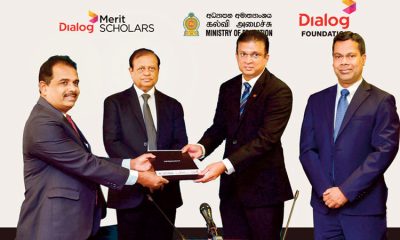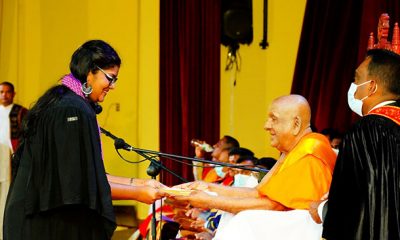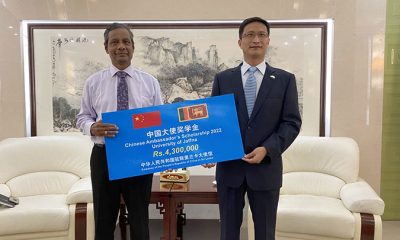Opinion
Connecting beyond Boundaries and Imaging sans Structures: Reflections of My Fulbright Experiences
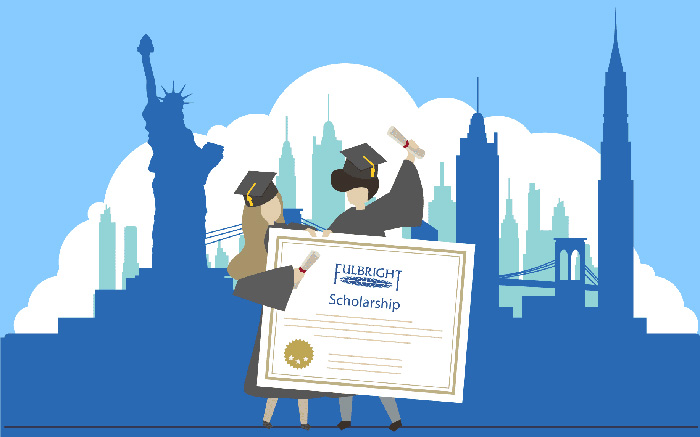
A speech made
by Prof. Gamini Keerawella
I deem it indeed a great honour to be invited me to deliver the keynote address, on the occasion of the 75th anniversary of the global Fulbright programme. For that, first of all, I do thank the US–Sri Lanka Fulbright Commission and its Executive Director, Ms. Sandharsee Gunawardena for giving me this opportunity.
I thought I should make use of this occasion to reflect on my Fulbright experience, unpacking the true value of the Fulbright programme in the changed context from the perspective of an academic, coming from the global South who benefitted from the Fulbright scholar exchanges.
The Fulbright programme is considered the US flagship international exchange programme, founded in August 1946, just 11 month after the end of Second World War, initiated by Senator William Fulbright, with the support of President Harry Truman and the Secretary of State Dean Acheson. Still, the dust created by WW-II was not settled. At the end of the WWII, the United States emerged as the Superpower with a new global role and reach. It was in this context that Senator William Fulbright presented the Fulbright Bill to amend the Surplus Property act of 1944 to use the revenue from the sales of US war properties in other countries to fund the educational exchanges between the US and participating countries. This birth trait of the Fulbright programme gave rise to its unique feature: the bilateralism. It is reflected in many National Fulbright Commissions such as the US-Sri Lanka Fulbright commission. As a political visionary from the standpoint of US strategic interests, Senator William Fulbright believed that education and diplomacy would be invaluable tools of US foreign policy in the changed international context after the II World War.
Before long, the international politics in the Post-War world was determined by the global-scale, multi-faceted strategic completion between the United States and the Soviet Union, identified as the Cold War. The world politics was polarised into two poles, the Soviet and the Western. The de-colonisation process gave birth to another category in global politics termed as the Global South. The both superpowers were competing in the Global South each other for influence. In this context, the Fulbright programme became a key foreign policy tool of the United States. That is the origin of the Fulbright exchange programme.
During the last 75 years, the Fulbright programme expanded rapidly, changing its purpose and character. It has generated consequences and dividends, unexpected by its founders. The first country to sign Fulbright agreement was China in 1947; it was followed by Burma. Today, each year bout 800 scholars and ,000 US students receive Fulbright awards and go abroad while 4,000 foreign students and 900 scholars receive awards to come to US. In the past 75 years, over 310,000 Fulbright students, scholars and teachers benefitted by the exchange programme.
Before I reflect on my Fulbright experience, please permit me to reveal my background briefly to place it in a proper political and historical context.
I think I belonged to the first post-colonial generation in Sri Lanka, born after independence. I also represent the Post-1956 generation, a commonly used cliché to denote this generation 0The Children of 56. My parents were ardent supporters of the 1956 political change. To cut a long story short, we manifested the strengths and the weaknesses of the so-called Children of 56.
I come from a rural/village background and not really from urban. Educated from, K/Uduwa School, Galagedara up to the 5th grade, where my parents were teachers. From 6th grade, I moved to the Gampola Central College. My entire school education was in Sinhala medium. I gained admission to the University of Peradeniya in 1968.
We witnessed the evolution of post-colonial social and political environment in the country. We saw how the collapse of Bamumu Kulaya (Brown Sahibs) which coincided with the emergence and dominance of a new political class. During our teens, the youth political culture of the country was highly influenced by New Left political ideologies. The Cuban Revolution inspired our generation and Che Guevara was our hero.
Our worldview was shaped by the Anti-Vietnam War Movement and U.S. intervention in South-East Asia. The military coup in Chile against Elected President Salvador Allende and its CIA involvements further reinforced our anti-American sentiment. America is nothing but the US state, its corporate interests and the inner state. We did not see anything beyond ‘Ugly America’.
We were avowedly anti-American and uncritically anti-American. We had only straitjacket, stereotype image on America: The Yankee imperialism: threat to the world. The world was very simple: we were progressive and we wore red hats. The others were reactionary; they wore black hats.
I gained admission to the Peradeniya University in 1968. It was the heyday of the University of Peradeniya. The Sri Lankan universities at the time were centres of radical left politics.
In the academic sphere, we had a well-qualified academic staff. We followed the conventional British academic traditions. Disciplinary boundaries were very high; no inter-disciplinary dialogue at all. Academic hierarchy was also maintained rigidly.
In the sophomore year at the University of Peradeniya, I got involved in the youth front of the JVP. As a result, after the 1971 youth uprising I was arrested and detained in the Bogambara Prison. At the end of 1973, I was released from Bogambara. I resumed my undergraduate studies at the University of Peradeniya in 1974 and sat my final Examination in 1975. As I showed good promise in my BA (Hons.) examination, I was recruited to the academic staff of my alma mater in 1976. It was the turning point in my life.
I proceeded to Canada for my post-graduate studies in 1980. In 1982, I obtained my Maters from the University of Windsor, Canada, by presenting a thesis on the origins of the New Left in Sri Lanka and the 1971 uprising. I compared Sri Lankan New Left with the South American New Left. It helped me to examine critically my new-left influence.
For my doctoral studies, I enrolled myself to the University of British Columbia, Canada. I decided to combine Strategic Studies with History. I worked on the growth of Superpower Naval rivalry in the Indian Ocean and Sri Lankan Response. It was a unique experience and I went through real disciplinary metamorphosis there. I was in the Department of History. My supervisor was from the Department of Asian Studies; I took causes in International Relations from the Department of political science. My external supervisor was Prof Howard Wriggins, Professor of Political Science of University of Columbia, New York, from another country.
During my doctoral studies at UBC, I was introduced to the on-going academic discourse on ‘National Security’. By then, the theoretical parameters marked by the Realist School dominated the field of Security Studies were predominant. It was mainly state–centered and the security of the state in an anarchic international environment was the focal concern of the national security.
In the main stream of thinking, national security was defined as the protection of territorial integrity of the state vis-à-vis the threats originated from the external sources. The internal security of the state was taken for granted and, if there was any concern, it was dealt under the rubric of internal law and order problematic. In this strand of analysis, the national, security was nothing but the politico-military security of the state; the ‘hard’ military strategic security took precedent over the ‘soft’ economic dimension of security. In the Cold War context, the preoccupation of the discipline was mainly to analyse the central military strategic balance of the superpowers and their defense strategies. The concerns relating to the prevention of a nuclear war between the superpowers constituted the core of the international security studies. UBC is a great seat of learning and research. From University of British Columbia, I received the license to the world of academia, Ph.D.
In 1993, I won the Fulbright Post-doctoral Fellowshi to join the University of California, Berkeley. Berkeley is, no doubt, a unique university. It was the birthplace of the Free Speech Movement and the Flower Power Movement of the 1960S. The impact of the Free Speech Movement and the Flower Generation was still visible at Berkeley. The research that I conducted during my Fellowship at Berkeley was ‘The Security of Small States in the Indian Ocean in the Post-Cold War context’.
In a vibrant academic environment at Berkeley, I was able to rethink the concept of national security. I myself deconstructed the Concept of National Security. What does ‘national’ in national security mean? What is security? What is national security? Can we equate National Security with State Security? What is really meant by security of the state? The real issue here is how to define the security of the state, going beyond narrow territorial confines. On the one hand, the state is a legal abstraction. On the other, it has a territorial basis and institutional framework of its own. The ideological basis of the state is the most important aspect of the state because it binds the territorial base with the human and institutional base with state. In addition, institutional set up of the state and human base of the state should also be taken into account.
The narrow definition of protection of territorial integrity from external threats is found to be inadequate in the face of new threat scenarios. In many third world states, the territorial integrity is challenged not externally but internally.
The territory is only one element of the state. The other elements of state including people and their security must also be taken into account in the security configuration.
As soon as people are taken as a referent object of national security, the analysis of threat and threat perceptions has to be invariably changed. The security building process involves the ability to meet and dispel threats and the reduction of vulnerabilities.
With the recognition of people as a reference of security, in its own rights, a variety of threats and vulnerabilities enter into the forefront of security analysis with different types of agents and sources of threat.
This line of thinking took me to the dual role of the state. One the one hand, State is the security provider; on the other hand it was a source of threat. Human rights, Rule of law, constitutionality and good governance become national security issues.
Berkeley experience under Fulbright Fellowship helped me to going beyond borders. It is not simply building connectivity crossing territorial boundaries. Indeed, crossing territorial boundaries are important. The territorial boundaries does not mean the physical territories. In our thinking, we are highly circumscribed by a small Island mentality. The besieged mentality in a small island is often presented ad patriotism. It is not patriotism. In order to get out of this besieged mentality you need to cross boundaries.
Crossing the pedagogic boundaries is equally important. Other two types of crossing boundaries are also equally important: First, Building connectivity, crossing theoretical borders within the discipline; Second, Building connectivity crossing disciplinary borders. It convinced me that symbiosis of approaches provides a new Synergy to view things from fresh perspective.
Further more, my Fulbright experience helped me to visualise the United States sans structures. In our undergraduate days we entertained a simple and monolithic view. In the world is of two categories: good and bad – Whit Hats and Black Hats mentality. Our earlier image of US was linked only to the set structure- The US State. It is true that State and society are inseparable entities. But I was convinced by my Fulbright experience to view ‘other America’ too. While admitting domination of corporate sector and the dominance of ‘inner state’, we need to pay attention to other social and political dynamics to understand complexity of US polity. It is not one colour Images. US is a country of many governments, many images, divers colors- just like proverbial bride’s gown; something green, something blue, something yellow and something green.
The most virulent critics of the US system can be found with the US. The vibrancy of US higher education institutions is remarkable. The most innovative
and radical thinking can be found in the US academic institutions. The Chicago school and writings of Jurgen Habermas is not an isolated example. The discourse on Gramsci, Foucault and Subaltern studies inspire Social Sciences in many key US academic institutions.
US system is complex and multifaceted. Internal dynamics of the system and checks and balances constituted an integral element of US system. This contributed to change the my lop-sided earlier view on America
US is not only the US State and its cooperate interests. The other-side of America is different. Fulbright experience helped me to separate US state and US society, to view the US people sans set structures. The US state, its apparatus and the US inner state constitute one dimension of America. There is other side of America, consisting great people US contribution to modern art and culture is great and we need view them delinking them with US state structures.
Contribution of US Musicians such as Garth Brooks, Elvis Presley, Eagles, and Michael Jackson reminds us the existence of other America. The great American poets such T. S. Eliot, Edgar Allan Poe, E.E. Cummings, Robert Frost reminds us the beauty of American culture alone with American Novelists such as F. Scott Fitzgerald, Ernest Hemingway. Mark Twain, Toni Morrison. John Steinbeck. While criticizing US state, its corporate interests and inner state, we enjoy US contribution to the culture of our age. Out attitude towards US state does not prevent us from enjoying US films such as Citizen Kane, The Godfather, A Space Odyssey, Gone with the wind, Lawrence of Arabia, The King and I and The Sound of Music.
In the new millennium, the significance of public diplomacy, such as the Fulbright scholar exchange program, must be viewed from a fresh perspective. The eclipse of utility of hard power and the increasing impotence of gunboat diplomacy highlights the soft power. In this context, not only the developments in the Wall Street but also developments in the main street are also come forward to determine the agenda of global politics. Referring to our backyard, the Indian Ocean, Robert D, Kaplan observed “for the first time since the Portuguese onslaught in the region in the early 16th century, West’s power there is in decline, however subtly and relatively. The Indians and the Chinese will enter into a dynamic great-power rivalry in these waters, with their shared economic interests as major trading partners locking them in an uncomfortable embrace. The United States, meanwhile, will serve as a stabilizing power in this newly complex area. Indispensability, rather than dominance, must be its goal”. Mobilizing US soft power potential is the best way to achieve ‘indispensability’.
The Fulbright exchanges highlighted the power of citizen diplomacy. Further, it gave the wider world an access to the positive contribution of the centers of leaning and knowledge, art and literature of the United States. Above all, it helped imaging US cans structures and building connectivity crossing many forms of boundaries. To conclude, I wish to quote Senator William Fulbright. He said on the occasion of 40th anniversary of the Fulbright Program in 1986, “Perhaps the greatest power of such intellectual exchanges is to convert nations into peoples and to translate ideologies into human aspirations. To continue to build more weapons, especially mote exotic and unpredictable machines of war, will not build trust and confidence”.
Opinion
A national post-cyclone reflection period?
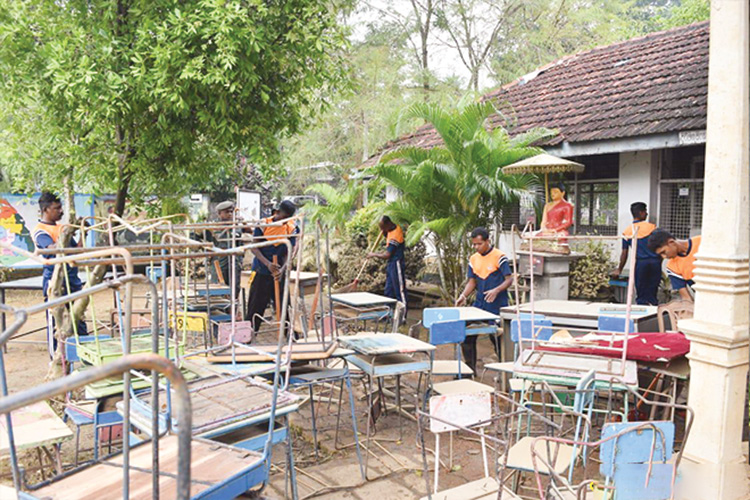
A call to transform schools from shelters of safety into sanctuaries of solidarity
Sri Lanka has faced one of the most devastating natural disasters in its post-independence history. Cyclone Ditwah, with its torrential rains, landslides, flash floods, and widespread displacement, has left an imprint on the nation that will be remembered for decades. While rescue teams continue to work tirelessly and communities rush to rebuild shattered homes and infrastructure, the nation’s disaster assessment is evolving by the day. Funds from government channels, private donations, and the Sri Lankan diaspora are being mobilised and monitored with care. Humanitarian assistance—from the tri-forces and police to religious institutions and village communities—has surged with extraordinary compassion, but as in every disaster, the challenge ahead is not only about restoring physical structures; it is also about restoring the social and emotional fabric of our people for a sustainable future.
Schools on the Frontline of Recovery
The Ministry of Education is now faced with a difficult but essential question: When and how should schools reopen? The complexity of the problem is daunting. Hundreds of schools are either partially submerged, structurally damaged, or being used as temporary shelters, bridges and access roads have collapsed, and teachers and students in highly affected districts have lost family members, homes, and belongings. And yet, not all regions have suffered to the same degree. Some schools remain fully functional, while others will require weeks of rehabilitation.
The country has navigated a similar challenge before. In 2005, following the tsunami that hit mainly the coastal areas of the island, the education system faced a monumental recovery phase, requiring temporary learning spaces, psychosocial support units, and curriculum adjustments. During the COVID-19 pandemic, schools reopened in staggered phases with special protocols. International schools and private educational institutions, with greater autonomy, are likely to restart their academic calendar earlier. Regardless of whether a school belongs to the national, provincial, Pirivena, or international sector, however, education must restart sooner rather than later. The reopening of schools is not merely an administrative decision; it is a symbolic and structural step toward national healing and a restorative future for the country.
Disasters Do Not Discriminate — Neither Should Education
Just like the tsunami of 2004, the major floods of 2016, the landslides of Aranayake (2016), Meeriyabedda (2014), and Badulla (2022), and the Covid-19 pandemic (2021), the cyclone Ditwah has once again exposed the fragile but deeply profound truth that natural phenomena do not recognize distinctions created by humans. Floodwaters do not differentiate between provinces, school systems, or social classes; landslides do not check national exam results before destroying a home; and suffering does not pause to ask whether a child is from a rural Mahaweli village or an elite urban suburb.
In this context, educational institutions have a responsibility that goes far beyond exams and syllabi. This aligns profoundly with an often-cited principle of Jesuit education articulated in 2000 by Fr. Peter-Hans Kolvenbach, S.J., the former Superior General of the Society of Jesus:
Tomorrow’s whole person cannot be whole without an educated awareness of society and culture, with which to contribute socially, generously, in the real world. Tomorrow’s “whole person” must have, in brief, a well-educated solidarity… learned through “contact” rather than “concepts.” When the heart is touched by direct experience, the mind may be challenged to change. Personal involvement with innocent suffering, with the injustice others suffer, is the catalyst for solidarity which then gives rise to intellectual inquiry and moral reflection.”
In this sense, schools must guide children to process what they have witnessed—directly or indirectly—and transform these experiences into moral resilience, empathy, environmental consciousness, and collective responsibility. In doing so, one should bear in mind that every child in Sri Lanka has experienced Cyclone Ditwah in some way:
Children Who Faced the Disaster Directly:
Some children lived through the cyclone in the most harrowing ways—watching floodwaters creep into their homes, escaping rising torrents, or fleeing as landslides tore through familiar ground. Their memories are filled with the sound of rushing water, collapsing earth, and the frantic efforts of parents and neighbours, losing their family members, and trying to keep everyone safe.
Children Who Supported Frontline Families:
Others experienced the crisis through the lens of responsibility. They watched fathers, mothers, siblings, or relatives join rescue teams, distribute supplies, or help evacuate neighbours. These children carried a different kind of fear—waiting in silence, praying that their loved ones would return safely from dangerous missions.
Children Who Witnessed the Disaster Through Media:
Many encountered the cyclone from within their homes or shelters, glued to phones, televisions, and social media feeds. They saw images of villages underwater, families stranded on rooftops, frantic cries for help, boats battling fierce currents, and choppers airlifting stranded people. Even from a distance, these scenes left deep emotional imprints.
Children Who Internalised the Atmosphere of Fear:
Some were not exposed directly to images or destruction, but absorbed the tension in their households—whispered conversations, worried faces, disrupted routines, and sleepless nights. Their experience was shaped by the emotional climate around them: the uncertainty, the stress, and the unspoken fear shared by the adults they depend on.
Children Who Got Involved in Relief Efforts:
Across Sri Lanka, countless children became active participants in relief efforts—some spontaneously, others through families, schools, churches, temples, mosques, and youth groups. Individually, they helped neighbors carry belongings, comfort younger children who were frightened, fetch water and dry rations, and assist the elderly in evacuation centers. Within families, many helped prepare meals for displaced people, sorted clothing donations, packed dry-food parcels, and joined parents in visiting affected households. Through organizations, such as temples, churches, mosques, charity foundations, school associations, clubs, scout groups, Girl Guides, Sunday school units, youth groups, and student unions, children coordinated collection drives, raised funds, gathered books and uniforms for those who are affected, and volunteered at distribution points. These acts, small and large, are beacons of the nation’s hope, revealing that even a crisis as destructive as Cyclone Ditwah, Sri Lankan children were not only making meaning of suffering, but also cultivating compassion, solidarity, and shared responsibility.
In one way or another, Sri Lanka’s children have been touched by the experience. Their hearts are stirred. Their minds are open. While not all trauma comes from direct contact, indirect exposure can be equally jarring, especially for younger children; their psychological, emotional, and social well-being must be handled with sensitivity and foresight. This moment, therefore, is an educational opportunity of rare depth—if we have the courage and creativity to embrace it.
A National Post-Cyclone Reflection Period (NPCRP)?
Once schools reopen, no child should simply return to the classroom as if nothing happened. A top-down insistence on “catching up” academically without addressing emotional wounds will only store up psychological problems for the future. Instead, schools should designate an initial period for reflection, storytelling, sharing, healing, and meaning-making. Hence, a mandatory National Post-Cyclone Reflection Period (NPCRP) is not merely a “feel-good” recommendation. It draws from post-tsunami educational reforms both in Sri Lanka (2004) and in Japan (2011), WHO frameworks for psychosocial healing in schools, UNICEF guidelines on post-disaster learning environments, and our own cultural traditions of collective mourning and remembrance in Sri Lanka. In Sri Lanka, villages often come together after a death for almsgivings, month-mind ceremonies, etc. Our religions—Buddhism, Christianity, Islam, and Hinduism—each emphasize compassion, reflective mourning, and community healing. Why should schools not embody these cultural strengths after a catastrophe that has impacted an entire nation?
(To be concluded)
(Dr. Rashmi M. Fernando, S.J., is a Jesuit priest, educator, and special assistant to the provost at Loyola Marymount University, Los Angeles, California, USA.).
by Dr. Rashmi M. Fernando, S.J.
Opinion
Venerable Mettavihari Denmarke passes away

Danish Monk Who Revolutionised Digital Buddhism and World’s Buddhist Media
The Buddhist community in Sri Lanka and around the world is mourning the passing of Venerable Mettavihari Denmarke, the Danish-born monk whose pioneering work transformed the modern dissemination of Theravada Buddhism. He passed away peacefully in Denmark recently, after battling with cancer.
Born Jacub Jacobson, a Christian and a successful businessman in Denmark for more than 18 years, he was drawn to the timeless truth of the Four Noble Truths and the serenity of the Noble Eightfold Path. This spiritual awakening led him to the Buddhist Order, where he was ordained under Ven. Agga Maha Panditha Madihe Pannaseeha Maha Nayake Thera, receiving the name Bhikkhu Mettavihari.
A Life Rooted in Sri Lanka
Venerable Mettavihari first arrived in Sri Lanka in 1969 and immediately felt a deep connection to the island and its people. Inspired by the purity of the Dhamma, he made Sri Lanka his permanent home. In 1988, both he and his wife entered the Buddhist Order – he as a monk and she as a nun dedicating themselves wholeheartedly to the Sasana.
Remembered for Compassion and Humility
I was fortunate to associate with him for over 10 years on several projects. His kindness towards all living beings and his sincere practice of the Dhamma were exemplary even for monks.
I recall one occasion when he attended a full-day workshop on neuroscience and Buddhism simply to encourage me. He stayed throughout, offering blessings and support. That day the devotees responsible for bringing Dana were late, yet he asked only for a piece of bread, as he was committed to maintaining the Vinaya discipline of eating before noon.
He was often seen walking barefoot on alms rounds gentle, humble, and entirely detached from worldly comforts.
His studio was always open to me, welcoming any noble work and encouraging efforts to help people lead meaningful, wholesome lives.
He was a strict Vinaya practitioner, a monk of exceptional discipline, simplicity, integrity, compassion, loving-kindness, and empathy that were beyond imagination.
A Pioneer of Digital Buddhism
Before his ordination, Venerable Mettavihari worked in the IT field in Denmark. He used this expertise to usher Buddhism into the digital age.
Through metta.lk, he created one of the world’s earliest online Buddhist databases, digitising the Tripitaka and making it available in three languages. He also provided email services to temples and ensured that Dhammapada verses accompanied each message quietly spreading the Dhamma across the globe.
Founder of Dharmavahini – Sri Lanka’s First Buddhist TV Channel
He founded Dharmavahini, Sri Lanka’s first Buddhist television channel, run by a small team of volunteers with minimal resources. More than a broadcaster, Dharmavahini was his effort to restore forgotten values in Sri Lankan society.
Today, it remains a landmark contribution to Buddhist media.
Educational Reformer – Founder of Learn TV
After witnessing the educational challenges faced by rural children following the 2004 tsunami, Venerable Mettavihari launched Learn TV, a 24-hour educational channel developed with the Ministry of Education.
This enabled thousands of students, especially those without tuition or teachers, to receive continuous, curriculum-based lessons from home.
A Monk Who Became Sri Lankan at Heart
Fluent in Sinhala and immersed in Sri Lankan culture, he often referred to himself simply as “a Sri Lankan.” During a conversation with friends, he humorously admitted that speaking Danish had become difficult, “because I am now a Sri Lankan.”
Noble Life and a Lasting Legacy
Most Venerable Mettavihari (aged 80)
With boundless compassion and humility, he uplifted countless lives through education, media, technology, and the Dhamma.
His legacy includes:
- Digitising the Tripitaka and pioneering online Buddhist resources
- Establishing Dharmavahini, Sri Lanka’s first Buddhist TV channel
- Launching Learn TV to uplift rural education
- Advancing global Buddhist communication through IT
- Strengthening moral values in Sri Lankan society
He was also an ardent supporter of the Light of Asia Foundation since its inception. He supported and guided the production of the Siddhartha movie, the establishment of the Sakya Kingdom, the International Film Festival, and, just a few months ago, he participated in the first production of a short video series on the Sutta which is currently under production and expected to be launched soon.
His life stands as a rare example of innovation, devotion, and deep spiritual conviction.
Venerable Mettavihari passed away mindfully at his home in Denmark.
His passing is a profound loss not only for Sri Lanka, but for the world.
May this noble monk attain the supreme bliss of Nibbana
Lalith de Silva
Former President, Vidyalankara Maha Pirivena Trustee, Light of Asia Foundation
Opinion
Maha Jana Handa at Nugegoda, cyclone destruction, and contenders positioning for power in post-NPP Sri Lanka – I
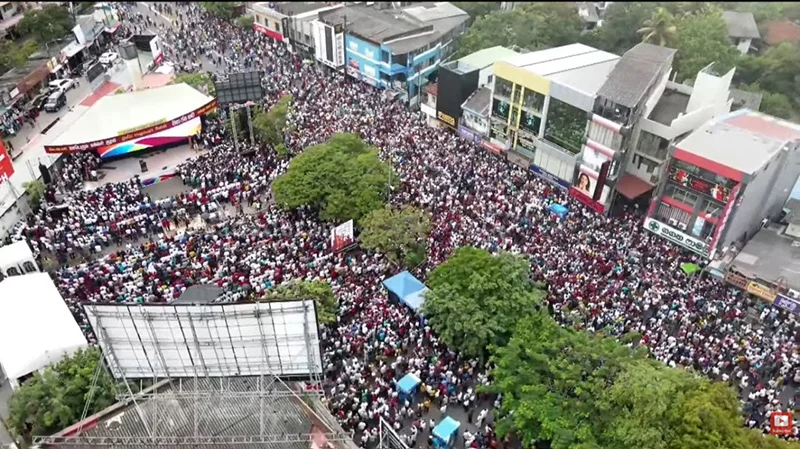
The Joint Opposition rally dubbed the ‘Maha Jana Handa’ (Vox Populi/ Voice of the People) held at the Ananda Samarakoon Open Air Theatre, Nugegoda on 21 November, 2025 has suddenly acquired a growing potential to be remembered as a significant turning point in post-civil conflict Sri Lankan politics, in the wake of the meteorological catastrophe caused by the calamitous Ditwah cyclonic storm that devastated the whole country from north to south and east to west on an unprecedented scale. But the strength of this prospect depends on the collective coordinated success of the future public awareness raising rallies, promised by the participating opposition parties, against the incumbent JVP-led NPP government. They are set to expose what they perceive as the government’s utterly inexperienced and unexpectedly authoritarian stand on certain vitally important issues including the country’s national security and independence, political and economic stability, and the Lankan state’s unitary status. The government is also alleged to be moving towards establishing a form of old-fashioned single party Marxist dictatorship in place of the firmly established system of governance based on parliamentary democracy, which was almost toppled by the adventitious Aragalaya protest of 2022 but saved by the timely intervention of some patriotic elements.
The minefield of policy making that the government must negotiate is strewn with issues including, among others: the seven or so recent agreements or MOUs (?) secretly signed with India; the unresolved controversy over the allegedly illegal clearance of some 323 containers (with unknown goods) without mandatory Customs inspection, from the Colombo Port; the Prime Minister’s arbitrary, apparently ill-considered and hasty education reforms without proper parliamentary discussion; the proposed culturally sensitive lgbtqia+ legislation non-issue (it is a non-issue for Sri Lanka, given its dominant culture); the so-called IMF debt trap; dealing with the unfair, virtually unilateral UNHRC resolutions against Sri Lanka; the inexplicably submissive surrender of the control of the profit-making Colombo Dockyard PLC to India; some government personal assets declarations that have raised many eyebrows, and the government’s handling of anti-narcotic and anti-corruption operations. The opposition politicians relentlessly criticise the ruling JVP/NPP’s failure to come out clean on these matters. But they themselves are not likely to be on an easy wicket if challenged to reveal their own positions regarding the above-mentioned issues.
In addition to those problems, the much more formidable challenge of unsolicited foreign-power interference in Sri Lanka’s internal affairs, in the guise of friendly intervention, remains an unavoidable circumstance that we are required to survive in the geostrategically sensitive region where Sri Lanka is located. Having been active right from the departure of the British colonialists in 1948, the foreign interference menace intensified after the successful ending of armed separatist terrorism in 2009. Such external interferences are locally assisted by latent domestic communal disharmony as well as real political factionalism, both of which are normal in any democratic country.
The war-winning President Mahinda Rajapaksa, as the leader of the SLFP-led United People’s Freedom Alliance (UPFA), was made to suffer a largely unexpected electoral defeat in 2015 through a foreign-engineered regime change operation that tacitly favoured his key rival, UNP leader Ranil Wickremesinghe. Mahinda was betrayed by his most trusted lieutenant Maithripala Sirisena.
The SLFP, a more middle of the way socialist-leaning rival political party, was formed in September 1951—five years after the birth of the UNP—and was elected to power in 1956, ending a near decade under the rather West-friendly latter party. It was deemed to be a ‘revolution’ that started an era of ‘transition’ (from elitist to common citizen rule). From nominal independence in 1948, governing power has to date alternated between these two parties or alliances led by them, except for the last electoral year, 2024. Though incumbent Executive President Anura Kumara Dissanayake may be said to have made history in this sense, the fact remains that he was barely able to scrape just 43% of the popular vote as the head of a newly formed, JVP-led NPP. Dissanayake was sworn in as President in September 2024. But his less than convincing electoral approval triggered a massive victory for the NPP at the parliamentary election that followed in November, giving him a parliament with 159 members, which is unprecedented in Sri Lanka’s electoral history.
In my opinion, there are two main reasons for this outcome. One is that the average Sri Lankan voters trust democracy. Since the president elect is accepted as having won the favour of the majority of the pan-Sri Lankan electorate, the general public choose to forget about their personal party affiliations and tend to vote for the parliamentary candidates from the party of the elected president. This is particularly true of the majority Sinhalese Buddhist community represented by the two mainstream, non-communal national parties, the UNP and the SLFP. The brittle foundation of that victory is not likely to sustain a strong enough administration that is capable of introducing the nebulous ‘system change’ that they have promised in their manifesto, while it is becoming clear that the general performance of the government seems to be falling far short of the real public expectations, which are not identical with the unconscionable demands made by the few separatist elements among the peaceful Tamil diaspora in the West, to whom the JVP/NPP alliance seems to owe its significantly qualified electoral success in 2024.
The Maha Jana Handa reminded me of the long Janabalaya Protest March from Kandy to Colombo where it ended in a mass rally on September 5, 2018. That hugely successful event was organised by the youth wing of the SLPP led by Namal Rajapaksa, who was an Opposition MP during the Yahapalanaya. He has played the same role just as efficiently on the most recent occasion, too. At the end of his address during the Maha Jana Handa, he declared his determination to bring down the malfunctioning JVP/NPP government at the earliest instance possible. Probably, he missed Ranil’s protege Harin Fernando’s speech that came earlier. This was because Namal Rajapaksa joined the rally midway. Harin had brought a message from his mentor Ranil to be read out to the rally audience. But he said he didn’t want to do so after all, saying that it was not suitable for that moment. Anyway, during his speech, Harin said emphatically that the era of heirs apparent or crown princes was gone for good. People knew that he was alluding to Sajith Premadasa and Namal Rajapaksa (sons of former Presidents hopeful of succeeding Anura Kumara Dissanayake). Harin was seen biting his tongue or sticking it out a little as he was preparing to leave the stage at the end of his address. Was he regretting what he had just said or was he cocking a snook at what, he was sure, was Namal’s ambition that would be revealed in his speech, the rally having been organised by the Pohottuwa or the SLPP? (To be continued)
by Rohana R. Wasala
-

 News2 days ago
News2 days agoOver 35,000 drug offenders nabbed in 36 days
-

 News6 days ago
News6 days agoLevel III landslide early warning continue to be in force in the districts of Kandy, Kegalle, Kurunegala and Matale
-

 Business4 days ago
Business4 days agoLOLC Finance Factoring powers business growth
-

 News4 days ago
News4 days agoCPC delegation meets JVP for talks on disaster response
-

 News4 days ago
News4 days agoA 6th Year Accolade: The Eternal Opulence of My Fair Lady
-

 News2 days ago
News2 days agoRising water level in Malwathu Oya triggers alert in Thanthirimale
-

 News1 day ago
News1 day agoCyclone Ditwah leaves Sri Lanka’s biodiversity in ruins: Top scientist warns of unseen ecological disaster
-
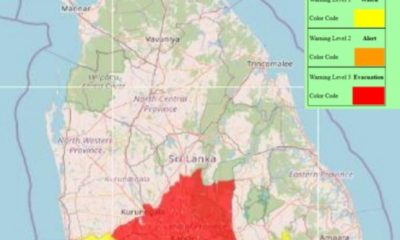
 Latest News4 days ago
Latest News4 days agoLandslide RED warnings continue to be in force for the Districts of Kandy, Kegalle, Kurunegala, Matale and Nuwara Eliya


